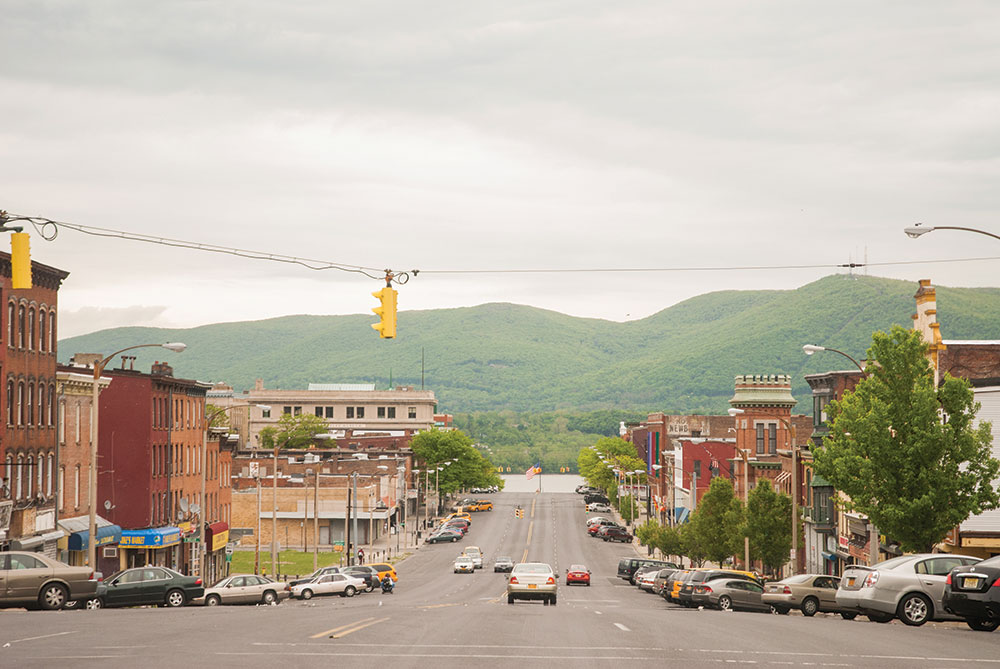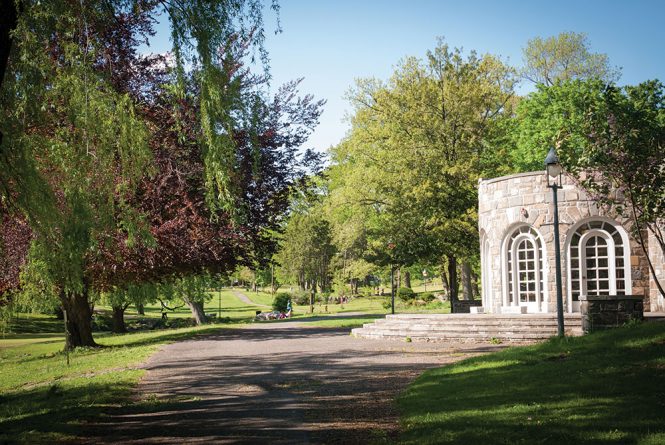Newburgh
Facing the Final Frontier
By Lynn Woods | Photos by Anne Cecile Meadows | Summer 2016 | Community Spotlight
Newburgh evokes a feeling of déjà vu—as well as one of vast potential. Anyone familiar with its history knows that it is capable of great highs and deep lows. Although Newburgh ranks as New York State’s most crime-ridden city, with a quarter of its population below the poverty line, its spectacular architecture and intact urban fabric are luring creative and entrepreneurial newcomers.
Located opposite Beacon on a bluff overlooking the Hudson River, a spot occupied by George Washington’s Continental Army, Newburgh flourished as an industrial center in the late 19th and early 20th centuries. Linked to New York by steamship and train, it produced woolens, felt hats, carpets, baking soda, tools, machinery, autos, and even ships. Newburgh was America’s second city—following New York—to install electrified streetlights, and in 1939 tested RCA’s first television sets. But in the early 1960s, thanks to urban renewal, the city lost its downtown and fell into precipitous decline.
Despite losing many buildings, the city of 27,000 remains an architectural gem, with blocks of Italianate, Gothic, Queen Anne, and Second Empire row houses; old brick industrial buildings; and charming, if dilapidated, churches. In the 1980s, urban pioneers began fixing up Victorian brick mansions on Montgomery and Grand Streets in the large East End National Historic District. The revitalization is finally gaining speed, with Brooklynites and artists buying up property. A ferry takes commuters daily to Beacon’s Metro-North train station, but many newcomers are establishing businesses here, like furniture maker Atlas Industries, Eco Shrimp, and Newburgh Brewing Company. A progressive mayor and city manager, a community land bank that’s getting hundreds of vacant buildings back onto the tax rolls, and a revised zoning code are at last enabling Newburgh to turn the corner.
The Scene
Restaurants along Newburgh’s redeveloped waterfront mainly cater to tourists, but retailers on Liberty Street are bringing Parisian-style living to the city. Opposite Washington’s Headquarters State Historic Site are several restaurants—including tin-ceilinged bistro Caffe Macchiato—a computer repair store, locksmith, juice bar, barber shop, wine store, wellness center, tavern, and florist. On Grand Street, Newburgh Art Supply occupies a restored 1850s manse. Broadway, purportedly the nation’s widest street (once crowded with wagons waiting to unload farm produce onto sloops) is also resuscitating. Up the street from SUNY Orange are Newburgh Mercantile, 2 Alices Coffee Lounge, and the historic Ritz Theater, where luminaries like Frank Sinatra and Lucille Ball debuted, which just got a new marquee. The Ritz belongs to the nonprofit Safe Harbors of the Hudson, a nonprofit that turned a rundown single-room-occupancy hotel into Ann Street Gallery and 128 apartments for artists and low-income, at-risk residents—and is about to break ground on a new park at the intersection of Broadway and Liberty Street.
Newburgh’s Last Saturdays include art openings and dance parties; an artists’ studio tour takes place in September. The Newburgh Illuminated Festival fills several downtown blocks in mid June. Farmers markets are held at the Ritz Theater and Downing Park, a greensward designed by Vaux and Olmstead, of Central Park fame. Newburgh Vintage Emporium runs a Farm, Vintage, and Makers Market every Saturday.

The 1934 stonebuilt Shelter House Visitor Center, near Polly Pond at Downing Park, was the city’s first revitalization project.
The Market
Prices range from under $30,000 for a distressed property to $425,000 for a fully restored mansion on the Hudson. A Queen Anne on the waterfront, with fireplaces, stained glass, beamed ceiling, and carriage house, is listed at $310,000. Two houses on “Quality Row,” a line of Federal-style homes on First Street, are selling for $159,000 and $200,000. Many buyers pay cash for historic properties in good condition, and there’s not a huge inventory. Turnkey properties start at $200,000. Buyers can apply for state and federal tax credits in the historic districts East End and Colonial Terraces (townhouses built in 1917 for ship workers). East End Victorians are most in demand, but rare; more opportunities exist in the Heights and western Newburgh, where four squares, bungalows, and other Craftsman-style houses abound.

Correction: The Newburgh Vintage Emporium outdoor market is select dates only, not every Saturday !!! The store with 45 dealers and 11,000 sq ft of antiques, vintage and repurposed treasures is open Tuesday thru Sunday 10-6 !!! Thank you for the mention !!!!
Property taxes are very high.
yes but look at what you get for that……lots of exciting dramatic events, a paid fire department, proximity to Manhattan, free Spanish lessons, buses to nowhere, great BarB Q and a riverboat or ferry ride, 40 churches in 4 square miles, buses to nowhere and Stewart Airport where planes fly to nowhere, and a view of Beacon.
Seriously, the emporium is awesome. Worth a visit.